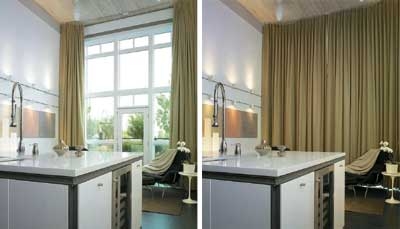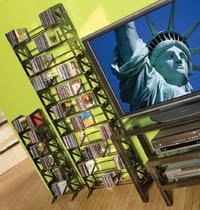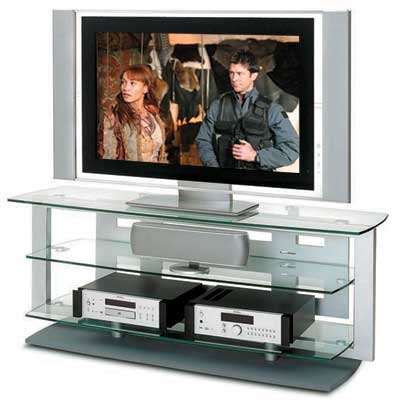Working the Room Page 3
Made in the ShadeYou'll also want to consider ways to control the ambient light in your room, especially if you have a projection setup and plan on watching movies during the daytime. "If you can't totally control the light, you're not going to have a great environment," Kaufman says. "You need something that totally blocks out light, or at least filters out 80% of it."  Lutron's drapery controls use keypad-controlled Sivoia QED (Quiet Eelctronic Drive) technology to keep the opening and closing of window and movie-screen curtains unobtrusive.
Lutron's drapery controls use keypad-controlled Sivoia QED (Quiet Eelctronic Drive) technology to keep the opening and closing of window and movie-screen curtains unobtrusive.
Most drapery stores can design custom shades and drapes that block most or all of the light coming through a window. Heavy drapes also serve double duty by reducing sound-marring reflections from the hard glass surface. (For more on acoustic remedies, click to read "Room Treatments.") Designers of high-end theaters often use motorized blinds and drapes like Lutron's Sivoia brand or those from MechoShade. But they're pricey - around $1,000 each for a 4 x 6-foot window - and require professional installation, which adds to the cost.
Another way to control ambient light is simply to repaint the room. "Keep the color palette subdued," suggests Kalomirakis. "Anything that's white or off-white reflects light, so the room never gets dark enough for viewers to focus on the screen." He recommends dark grays, blues, and reds.
"First of all," he says, "it makes the room stand out, because bright colors are used throughout many homes. A darker color gives the room a little more drama. And when the lights go down and the movie starts, the light from the screen doesn't bounce off the walls in a way that makes you constantly aware you're in a room and not in a movie theater."
Out of SightYou never see the equipment in a movie theater - just the screen. And with remote controls and onscreen displays, you don't need to have your gear out in the open.
"If you look at high-end home theaters, the equipment is seldom mounted on the same wall as the screen," says Hollander. "So if you have a closet off to the side or in the back of the room, it's better to have your gear located there. That way your screen stays unobstructed, and you don't have to spend a lot of money on fancy cabinetry to hide your equipment, which can go into a stand or rack in the closet. Then all you need is a remote-control 'eye' (sensor) in the front of the room that connects back to the hideaway gear."
 |
| The CD-150 (left) and CD- 600 CD racks from Boltz provide rigid storage for hundreds of discs. |
But if stashing away your equipment isn't an option - or you like having it out in the open - there's a myriad of modular storage solutions for components as well as discs and tapes from companies like Boltz, Sanus Systems, AV Mechanica, Bell'O, Salamander, Lovan, Soricé, and StudioTech. "All you really need to do is get it off the front wall - put it on the side wall or behind you," Hollander advises. "It can still be very prominent, but positioned in such a way that it doesn't detract from movie watching. And some gear lets you switch the display off while you're watching."
"There are so many equipment-friendly cabinets," observes Kalomirakis. "A lot of companies offer sophisticated media-center cabinets that accommodate all three front speakers, neatly organizing everything into a single unit." So what does this designer of big-budget private theaters use in his own home? "I use Ikea cabinets," Kalomirakis reveals. "They're very inexpensive, and one bookcase in Ikea's Billy storage system line costs only $249, has subdivisions for CDs and DVDs, and comes in a variety of finishes."
Getting PersonalAnd then there are accessories that let you personalize your home theater space. You can choose from hundreds of movie posters and dozens of frames for your walls, as well as a variety of cinema-themed coffee and end tables, throw pillows, carpets, bar towels, candle holders, paper-towel holders, light-switch plates, and still more from online suppliers such as Home Theatre Interiors, HTMarket.com, and Home Cinema Accessories.  BDI's Vector 9429 component rack uses a steel frame to support flat-screen TVs.
BDI's Vector 9429 component rack uses a steel frame to support flat-screen TVs.
For a signature start to an evening of movie watching, you can even order a personalized movie-introduction DVD from HTMarket.com or Home Theatre Interiors ($150), and they can also help you stock your very own concession stand with everything from an authentic theater-style popcorn popper ($500 to $1,500) to an old-fashioned soda fountain ($1,000 and up) to double-matinee-sized candy bars.
With so much cool stuff like this available, it's tempting to go overboard. "You want to keep it from becoming a distraction," counsels Hollander. "You're in the room to watch a movie, and it'll be harder to follow if there are too many other things to look at. I try to keep accessories in the back of the room or an adjacent room, like a foyer," he adds. "That's usually better than having, say, glass-covered movie posters on the side wall that are going to act like mirrors and reflect light."
Most people put a lot of time and money into planning and installing a home theater system. And since the system generally reflects the personality and style of the owner, it's only fitting that the room it's in should follow suit. "A home theater is a fun thing," Kaufman concludes, "so why not spend some money to personalize it?"
- Log in or register to post comments



































































